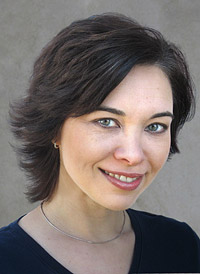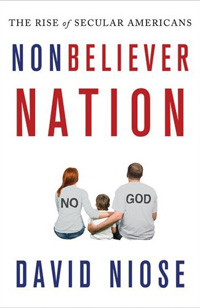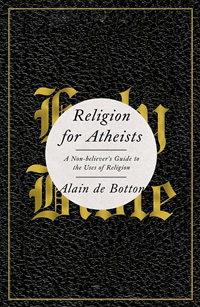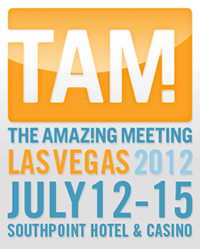In this week’s eSkeptic:

Skeptics are Redoubtable
The hosts of MonsterTalk interview Sharon Hill, creator of the website Doubtful News. The discussion includes updates on the latest in monster news trends, as well as information about The Amaz!ng Meeting—the James Randi Educational Foundation’s annual meeting of skeptical scientists, researchers, artists, performers, teachers and other rational-minded folk in Las Vegas, Nevada. Also in this episode, Brian Thompson of the JREF stops by to discuss TAM 2012.
About this week’s eSkeptic
In this week’s eSkeptic, Rachel Pridgen reviews two books: Nonbeliever Nation: The Rise of Secular Americans by David Niose (Palgrave/Macmillan, 2012, ISBN 13: 978-0-230-33895-1) and Religion for Atheists: A Non-believer’s Guide to the Uses of Religion by Alain de Botton (Pantheon, 2012, ISBN 13: 978-0-307-37910-8).
Rachel Pridgen is credited with preserving the sanity of countless women by hosting group therapy in the form of workout sessions, knit nights, and tea/wine parties. She is a freelance writer with a popular blog depicting her experiences as a freethinking mother in southern Alabama. Her areas of interest and research include religious psychology and early education; the history of philosophy and science; and the intersection between religious language and rational discourse. She is the headmistress and executive director of the Pridgen Ninja Jedi Training Academy for Precocious Children, and she deeply regrets allowing her sons to name their homeschool.
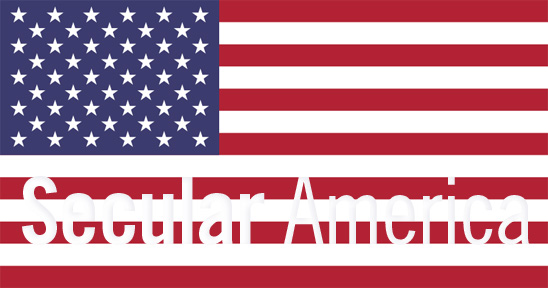
One Nation, Another Religion?
by Rachel Pridgen
Having grown up in Southern California during the Reagan years nothing would have led me to challenge the assumption that all Americans believed in God. We had strong Evangelical leaders and it was evident that God had manifestly blessed America and allowed us to thrive and flourish. To be sure, there were two kinds of Americans: those with vibrant belief and those with apathetic belief. But Americans with no belief? Those existed in the same way ogres, evil wizards, and traitors existed—in a mythical ghetto where we were free to abhor them without actually encountering them. Born into a Christian family during the growth spurt of the religious right, I was unaware of the existence of secular Americans.
“Growing up” for me therefore meant (among many other things) encountering the reality of free thought in America and the humanity that lies behind it. As I asked more questions and my faith failed, I was amazed to find a sizable and thriving secular community beyond my believer bubble.
David Niose, President of the American Humanist Association and Vice President of the Secular Coalition for America presents a new book full of information on secular Americans. Nonbeliever Nation provides a framework for understanding the role of secular Americans, the obstacles they face, and their vision for the future. Niose’s treatment, while not exhaustive, ably maps the American secular experience sociologically and demographically. He begins with demographic data revealing a population in transition. Secularity in America is growing through a change in both belief and identity. It is still an unfortunate reality that disbelief is marginalized in the United States. Open secularity is still not as common as it should be based on the numbers. Tellingly, 81% of Americans report a belief in a divinity, but only 1.6% identify as atheist or agnostic. This means approximately 1 in 6 Americans don’t believe in a divinity, but are unwilling to identify as a non-believer.
The social stigma attached to atheism causes many to remain unidentified regardless of actual belief. This is particularly interesting if one looks at the results of increased religiosity. It would appear that we are not any better off for all of our high rates of fundamentalist beliefs. We have one of the highest homicide rates of all industrialized countries, and Niose provides quotes and statistics to show that “higher rates of belief in and worship of a creator correlate with higher rates of homicide, juvenile and early adult mortality, STD infection rates, teen pregnancy and abortion.” It turns out that belief in God does not necessarily help us to be more moral, and in fact may result in just the opposite. Despite this information, surveys show that atheists remain the most distrusted minority in America, surpassing even rapists and pedophiles.
Niose uses his opening chapters to establish the fact that secular Americans were not always so closeted. In fact, it came as a surprise to many that the Religious Right gained such a strong foothold in American politics. Many simply believed that religious fundamentalism would decline as scientific advances and critical thinking skills increased. This prediction has proven false as the Religious Right has maintained its political clout through heavy marketing strategies, use of emerging technology to reach new markets, and the marginalization of secular culture. Religious conservatives also made extensive use of revisionist historians in order to promote the idea of a conservative Christian tradition in the founding and history of America. Though there are more complete treatments of the secular tradition in America to be found, Nonbeliever Nation provides an excellent overview without getting dragged away from its main focus.
On the matter of secularity and morality, for example, after addressing the evidence that increasing religiosity has not made America a more moral nation than its less religious peers, Niose provides a succinct, accessible overview of the concepts of evolved morality and the benefits of adherence to social norms. For those unfamiliar with the concepts, this presentation is extremely easy to understand, and for those who have already explored these concepts, Niose communicates a sizable amount of complex information without overloading readers.
After laying this sturdy framework, attention is turned to the current problems facing secular Americans. The most pressing problem is not that religion exists or that people believe in God, but that so many of these religious beliefs are being made a matter of public policy. Niose is quick to point out that individual belief is not nearly as problematic as the policies that come out of these beliefs. Unfortunately, the Religious Right views even attempts at religious neutrality as hostile attacks, and are willing to throw large quantities of resources at those who will create more Christian policies. This becomes a problem for secular Americans when the goals of the Religious Right involve anti-intellectualism, revision of textbooks, promotion of public prayer, and discrimination against those without a belief in god.
Now the good news: secular Americans are emerging. Activism is on the rise, people are identifying and organizing in order to influence sound policy, and student activism especially is growing by leaps and bounds. Thanks in large part to the Internet, communities of secular Americans are uniting and working together to make themselves known and heard. College students across the nation are working together to form student alliances, and even high schools are beginning to see the formation of secular student groups. Despite opposition, these groups can legally meet thanks to rights that were originally won by religious groups attempting to gain access to students, so there is a bit of quid pro quo there!
Niose observes that the secular movement is learning a lot from the work of other minority groups, most noticeably, the LGBT movement, which has made great strides in recent years by advocating an identity campaign. Encouraging their members to openly identify and make themselves known has allowed them a public presence, the ability to organize, and a common ground for influence. Niose believes that secular Americans need to adopt this strategy as well in order to move forward and enable change. Unless secular Americans make their presence known, they have little hope of influencing public policy or changing public perceptions. But as Niose emphasizes, this is happening, especially among young people. There is hope that change is imminent. With solid education and awareness, more non-believers will be accepted within the political sphere.
The largest remaining need is that of a solid secular community. Niose states that “religious institutions offer tradition, cultural continuity, and a place to find peace of mind through ritual, meditation, and contemplation. As long as this is not infringing on anyone else’s rights, this can be all good.”
To that end, Alain de Botton offers Religion for Atheists, an interesting read that is sure to stir up conversation and controversy. His thesis is simple: Religion does some things well, and the secular community should unapologetically steal those things. It is de Botton’s goal to create a secular culture with religious (though not supernatural) influences. Though the number of atheists attending Unitarian Universalist churches bears testimony to the validity of some of his claims, de Botton fails to recognize that adding ritual and organization to secular communities does little to avoid the structural problems inherent in religious groups and is unlikely to provide enough positives to outweigh the negatives of dogmatism, propaganda, and various other issues.
De Botton asserts that the creation of community is the easiest and most obvious of the areas in which religions excel. Houses of worship are gathering places for people of varying ages and social classes. Once a week, the faithful are encouraged to set aside their personal differences in order to affirm common beliefs as members of a group. While many will argue that the reinforcement of beliefs is unnecessary, it is hard to argue with the way religions provide an instant social network for their members.
The reinforcement of beliefs is also something that de Botton believes non-believers could adopt. Religion for Atheists points to the methods that churches use to both transmit and affirm beliefs as valuable tools for educators. He argues that while higher education teaches us how to make a living, it doesn’t provide a framework for living well. Churches teach application of values found in its music, writings, and art. They excel at teaching through ritual and repetition. And the best churches employ strong orators who know how to command an audience and draw people in to their topic.
Art and architecture also receive extensive time, though there are many who would criticize the extremes of de Botton’s examples. Religions have historically been very good at using art as propaganda. Not only do they create and commission art, they provide a ready-made framework for interpreting it. The church tells its members exactly how to think and feel about the art they provide. The non-religious do this as well, only it’s called “advertising.” De Botton goes on to say that we should attempt to provide similar interpretive frameworks within our museums, organizing art by topic, emotion or general feeling instead of chronologically or by genre. While it’s an interesting idea, I think it would effectively cut off many observers from their own interpretations.
And this is the problem with many of the suggestions offered in Religion for Atheists. Establishing community is a pretty good idea. Establishing restaurants where patrons are seated with random strangers and instructed to discuss their deepest fears is not a very good idea. Encouraging kindness, creating more beautiful spaces, and finding meaning in life are all great. The idea that we need to establish secular organizations to do these things in ritualistic ways is probably not necessary.
There are other topics where de Botton may find even greater opposition. One chapter claims that the non-religious don’t have enough reminders of the transcendent and that they lack big picture perspective. That has simply not been my experience, nor do I find it to be the experience of the nonbelievers I know. In fact, if anything it seems that most skeptics are more aware of their own insignificance and the fragility and brevity of life, along with the transcendent feelings one gleans from a cosmological and evolutionary perspective.
Both of these books provide valuable food for thought. Niose’s examination of the secular situation in America, its history, and suggestions for the future give hope that secularity will continue to grow and suggest practical ideas for participation in the movement. Due to my recent deconversion, De Botton should have a devoted fan in me. I feel the same pangs toward ritual and the things that the religious community did well as far as establishing community. I even feel the occasional desire to listen to a rousing sermon, though I find debates and lectures to be far more interesting and educational. Unfortunately, I found myself rejecting most of his suggestions. The good news: de Botton’s ideas are just crazy enough to get people talking. While discussing some of the more ridiculous options, we can evaluate whether secular America truly is missing anything, determine what it is, and perhaps come up with ways to fill that need. While it is true that the secular community often throws out the baby with the bathwater when it comes to avoiding similarities to religion, I’m not sure we need to start holding secular baptisms just yet.
Skeptical perspectives on faith, atheism and morality…
-
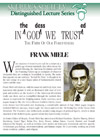 The Faith of Our Forefathers
The Faith of Our Forefathers
by Frank Miele -
Skeptic magazine Senior Editor Frank Miele begins by showing how, when religious fundamentalists call for a return to moral standards, they hold the founding fathers up as exemplars of whatever viewpoints they are seeking to “reestablish” in society. Miele shows how inaccurate this picture is with a slide tour of religion and politics as the revolutionary leaders really saw them. After seeing this lecture you can answer the claims of conservatives and fundamentalists that American was founded as a Christian nation… Order the lecture on DVD.
-
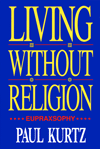 The Living Without Religion
The Living Without Religion
by Paul Kurtz -
One of America’s foremost expositors of humanist philosophy, Paul Kurtz shows how we can live the good life filled with morality, commitment, and dedication, without having to depend on the existence of a higher being. Drawing upon the disciplines of the sciences, philosophy, and ethics, Kurtz also offers concrete recommendations for the development of the humanism of the future. An entire section of the book is devoted to the careful definition of religion, which clearly demonstrates than an authentic moral life is possible without religious belief… Order the book.
-
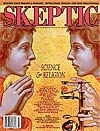 Science and Religion
Science and Religion
Skeptic magazine Vol. 8 No. 2 -
In this issue: Are Science and Religion Compatible?; Faith of the Fatherless: The Psychology of Atheism; Rocks of Ages: Science and Religion in the Fullness of Life, by Stephen Jay Gould; The Natural & the Supernatural: Science, Religion & their Defenders; Finding Darwin’s God: A Scientist’s Search for Common Ground Between God and Evolution; Holy Man, Holy War, Wholly Fiction; Skeptics and True Believers: The Exhilarating Connection Between Science and Religion…
Order the back issue.
-
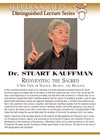 Reinventing the Sacred: A New View
Reinventing the Sacred: A New View
of Science, Reason & Religion
by Dr. Stuart Kauffman -
In this controversial lecture based on his new book, the world-renowned complexity theorist Dr. Stuart Kauffman argues that people who do not believe in God have largely lost their sense of the sacred and the deep human legitimacy of our inherited spirituality, and that those who do believe in a Creator God, no science will ever disprove that belief. Kauffman believes that the science of complexity provides a way to move beyond both reductionist science and dogmatic theology to something new: a unified culture where we see God in the creativity of the universe, biosphere, and humanity…
Order the lecture on DVD.
-
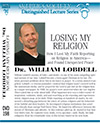 How I Lost My Faith Reporting on Religion
How I Lost My Faith Reporting on Religion
in America—and Found Unexpected Peace
by William Lobdell -
William Lobdell’s journey of faith—and doubt—is one of the most compelling spiritual memoirs of our time. Lobdell became a born-again Christian in his late 20s and the Los Angeles Times asked him to write about faith. While reporting on hundreds of stories, he witnessed a disturbing gap between the tenets of various religions and the behaviors of the faithful and their leaders. He investigated religious institutions that acted less ethically than corrupt Wall Street firms. He found few differences between the morals of Christians and atheists. As this evidence piled up, he started to fear that God didn’t exist. He explored every doubt, every question—until, finally, his faith collapsed… Order the lecture on DVD.
Announcing The Amaz!ng Meeting 2012
Southpoint Hotel & Casino, Las Vegas, NV
July 12–15, 2012
THE AMAZ!NG MEETING (TAM) is an annual celebration of science, skepticism and critical thinking. People from all over the world come to TAM each year to share learning, laughs and the skeptical perspective with their fellow skeptics and a host of distinguished guest speakers and panelists.
The James Randi Educational Foundation (JREF) has hosted its annual Amaz!ng Meeting since 2003 as a way to promote science, skepticism and critical thinking about paranormal and supernatural claims to the broader public. TAM has been held in Las Vegas, NV since 2004 and has become the world’s largest gathering of like-minded science-advocates and skeptics.
With yet another incredible lineup of speakers, hands-on workshops, and entertainment, this is sure to be an Amaz!ng Meeting you won’t want to miss! Check out the entire program, and follow @jref on Twitter for the latest #TAM2012 news and announcements.


